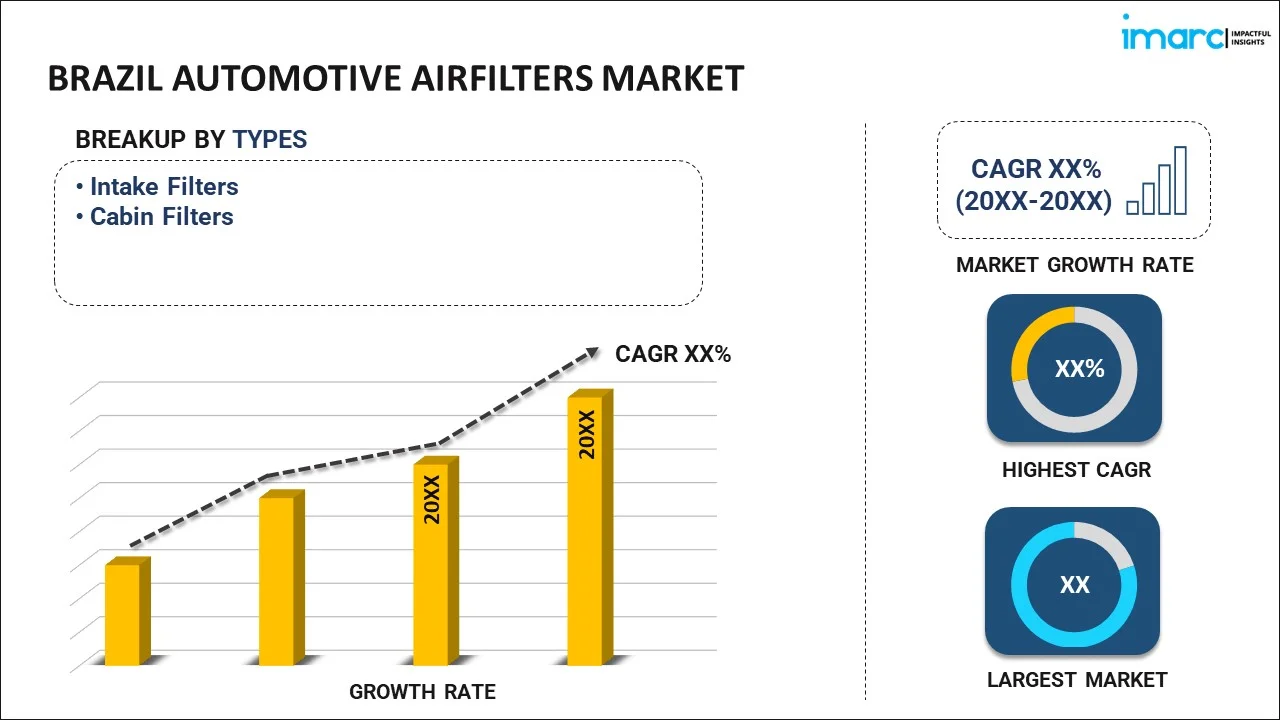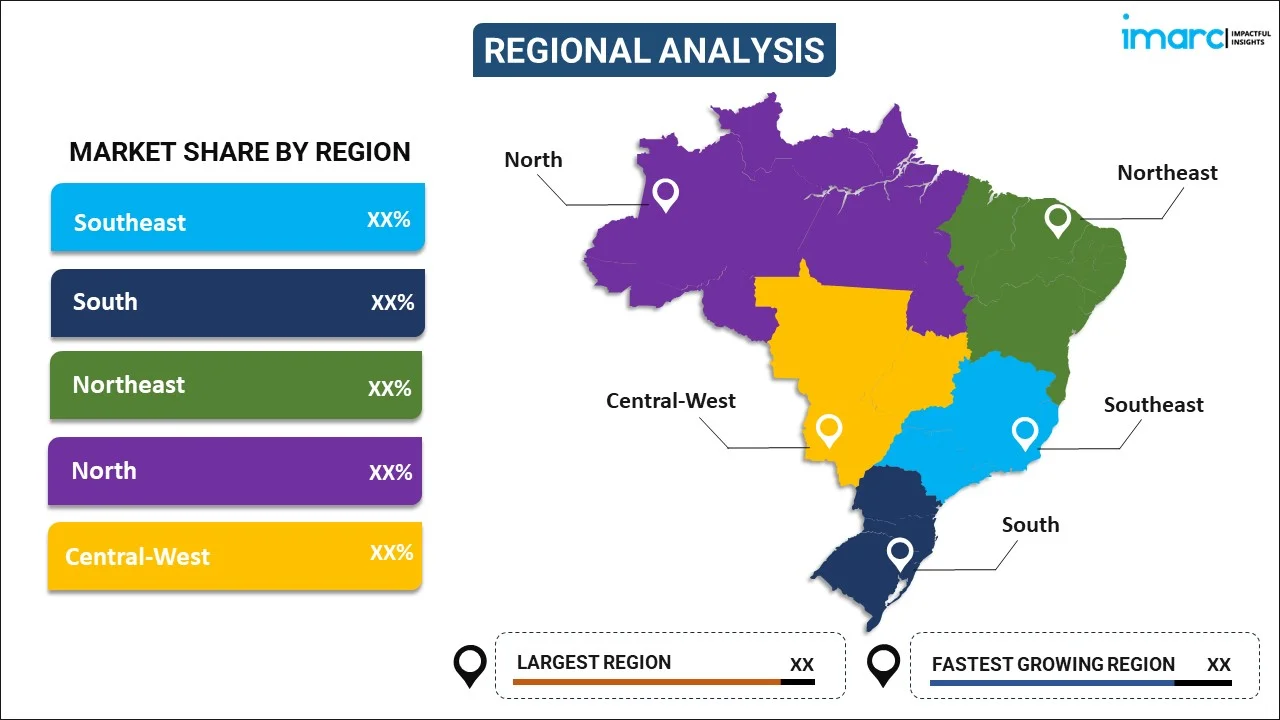
Brazil Automotive Airfilters Market Report by Type (Intake Filters, Cabin Filters), Material Type (Paper Airfilter, Gauze Airfilter, Foam Airfilter, and Others), Vehicle Type (Passenger Cars, Commercial Vehicles), Sales Channel (OEMs, Aftermarket), and Region 2026-2034
Brazil Automotive Airfilters Market Overview:
Brazil automotive airfilters market size reached USD 102.8 Million in 2025. Looking forward, IMARC Group expects the market to reach USD 153.6 Million by 2034, exhibiting a growth rate (CAGR) of 4.56% during 2026-2034. The expanding automotive industry in Brazil, surge in automobile manufacturing, growing urbanization and rising middle-class population in Brazil, heightened awareness of environmental issues, and enforcements of stringent emission norms and regulations in Brazil represent some of the key factors driving the market.
|
Report Attribute
|
Key Statistics
|
|---|---|
|
Base Year
|
2025 |
|
Forecast Years
|
2026-2034
|
|
Historical Years
|
2020-2025
|
| Market Size in 2025 | USD 102.8 Million |
| Market Forecast in 2034 | USD 153.6 Million |
| Market Growth Rate (2026-2034) | 4.56% |
Automotive airfilters refer to essential components used in vehicles to filter out airborne contaminants and impurities from the air before it enters the engine's combustion chamber. They are available in various types, including engine air filters and cabin air filters. Automotive airfilters are manufactured using multiple substances, such as paper, foam, and synthetic materials. They offer several key features, including an intricate design, high filtration efficiency, and the ability to protect the engine from premature wear. Automotive airfilters find applications in passenger cars, light and heavy commercial vehicles, two-wheelers, and off-road vehicles. Moreover, they are utilized in both gasoline and diesel-engine vehicles, hybrid cars, and electric vehicles (EVs). Automotive airfilters aid in improving engine performance, extending engine life, reducing fuel consumption, and enhancing air quality within the vehicle's cabin. In addition, they offer several advantages, such as cost-effectiveness, low maintenance requirement, ease of installation, better fuel efficiency, and reduction in harmful emissions.
Brazil Automotive Airfilters Market Trends:
Cabin Filters Witnessing Steady Uptick in Demand
In Brazil, more car owners are opting for automotive cabin air filter solutions due to increasing urban air pollution and rising awareness of respiratory health. Vehicle interiors are no longer just about comfort; they’re also expected to protect passengers from dust, pollen, and harmful particles. Automakers are responding by offering cabin filters as standard in newer models. Meanwhile, workshops and service centers are actively recommending replacements during regular maintenance. This shift is especially visible in metropolitan areas like São Paulo and Rio, where air quality concerns are driving higher replacement rates. Consumers now associate cabin filters with cleaner air, not just luxury, and this perception is pushing the segment forward.
Aftermarket Channels Gaining Strength
Brazil’s aftermarket for automotive airfilters is growing faster than the OEM segment. Older vehicles still dominate the roads, and their upkeep is fueling demand for cost-effective replacement parts. Local distributors, auto parts retailers, and online platforms are capitalizing on this by offering competitive pricing and wider availability. Many car owners and smaller garages prefer these aftermarket options for convenience and affordability. The surge in DIY car maintenance, especially among younger drivers, is also contributing. With import taxes affecting OEM prices, car air purifier kits and filters sold through independent sellers are becoming a more attractive choice across urban and rural markets.
Eco-Friendly Filters Attracting New Buyers
There’s a gradual but noticeable shift toward eco-conscious automotive components in Brazil, and airfilters are part of it. Manufacturers are introducing filters made with biodegradable materials or recyclable packaging to appeal to environmentally aware consumers. Car owners in Brazil’s urban centers, especially those driving hybrid or electric vehicles, are more inclined to choose sustainable alternatives. Green branding and regulatory pressure are also nudging larger suppliers to switch to less polluting production processes. The trend is still emerging but growing, and it’s aligning with broader movements toward cleaner transportation and ethical consumption within the automotive filter market.
Rising Demand for High-Performance Filters
Not all filters are equal, and more drivers in Brazil are starting to notice. Off-road enthusiasts, truckers, and fleet operators are seeking out specialized airfilters built to perform under demanding conditions, like unpaved roads, high humidity, or industrial zones. Filters that offer better particulate retention, longer service life, or compatibility with turbo engines are gaining ground. Suppliers are responding with products tailored to commercial vehicles, agricultural machinery, and SUVs. This demand is being driven by both performance needs and the economics of reduced engine wear. The market for these premium filters, though smaller, is becoming more visible and less niche.
Stricter Emission Controlling Fuel Filter Upgrades
Brazil’s regulatory bodies are pushing for cleaner vehicle emissions, and this has a direct effect on the filter market. New legislation tied to Proconve standards requires better filtration in both diesel and gasoline engines. Filters are no longer just optional maintenance; they’re essential for passing inspections. Engine airfilters that ensure optimal combustion and prevent soot buildup are in higher demand. This is especially relevant in the commercial and logistics sectors, where non-compliance can mean fines or operational downtime. Suppliers are under pressure to offer products that meet stricter filtration efficiency standards without compromising engine performance.
Auto Industry Expansion Supporting Market Growth
Brazil’s automotive sector is recovering steadily, and this expansion is lifting the airfilter market alongside it. New vehicle production, particularly in the passenger and light commercial categories, is reviving supply chains and boosting demand for OEM filters. Meanwhile, foreign investments and local incentives for carmakers are translating into new assembly lines and higher vehicle output. This growing base of vehicles on the road directly feeds into replacement cycles for filters. Additionally, increasing car ownership among the middle class means more vehicles in circulation, more service visits, and more airfilters being sold, both through dealerships and independent service centers.
Brazil Automotive Airfilters Market Segmentation:
IMARC Group provides an analysis of the key trends in each segment of the market, along with forecasts at the country level for 2026-2034. Our report has categorized the market based on type, material type, vehicle type, and sales channel.
Type Insights:

To get more information on this market, Request Sample
- Intake Filters
- Cabin Filters
The report has provided a detailed breakup and analysis of the market based on the type. This includes intake filters and cabin filters.
Material Type Insights:
- Paper Airfilter
- Gauze Airfilter
- Foam Airfilter
- Others
A detailed breakup and analysis of the market based on the material type have also been provided in the report. This includes paper airfilter, gauze airfilter, foam airfilter, and others.
Vehicle Type Insights:
- Passenger Cars
- Commercial Vehicles
The report has provided a detailed breakup and analysis of the market based on the vehicle type. This includes passenger cars and commercial vehicles.
Sales Channel Insights:
- OEMs
- Aftermarket
A detailed breakup and analysis of the market based on the sales channel have also been provided in the report. This includes OEMs and aftermarket.
Regional Insights:

- Southeast
- South
- Northeast
- North
- Central-West
The report has also provided a comprehensive analysis of all the major regional markets, which include Southeast, South, Northeast, North, and Central-West.
Competitive Landscape:
The market research report has also provided a comprehensive analysis of the competitive landscape in the market. Competitive analysis such as market structure, key player positioning, top winning strategies, competitive dashboard, and company evaluation quadrant has been covered in the report. Also, detailed profiles of all major companies have been provided. Some of the key players include:
- Advanced Flow Engineering Inc.
- Airaid
- K&N Engineering Inc.
- Mann+Hummel
(Please note that this is only a partial list of the key players, and the complete list is provided in the report.)
Brazil Automotive Airfilters Market News:
- In June 2024, Ahlstrom completed a EUR 2 Million investment in a new lamination line at its Louveira plant in Brazil. This move enhances local production capabilities for industrial air and fuel filtration materials, supporting demand across the South American automotive sector. Previously sourced from Europe and North America, these products can now be manufactured in Brazil, improving supply efficiency and reinforcing Ahlstrom’s presence in the region’s filtration market.
Brazil Automotive Airfilters Market Report Coverage:
| Report Features | Details |
|---|---|
| Base Year of the Analysis | 2025 |
| Historical Period | 2020-2025 |
| Forecast Period | 2026-2034 |
| Units | Million USD |
| Scope of the Report | Exploration of Historical and Forecast Trends, Industry Catalysts and Challenges, Segment-Wise Historical and Predictive Market Assessment:
|
| Types Covered | Intake Filters, Cabin Filters |
| Material Types Covered | Paper Airfilter, Gauze Airfilter, Foam Airfilter, Others |
| Vehicle Types Covered | Passenger Cars, Commercial Vehicles |
| Sales Channels Covered | OEMs, Aftermarket |
| Regions Covered | Southeast, South, Northeast, North, Central-West |
| Companies Covered | Advanced Flow Engineering Inc., Airaid, K&N Engineering Inc., Mann+Hummel, etc. |
| Customization Scope | 10% Free Customization |
| Post-Sale Analyst Support | 10-12 Weeks |
| Delivery Format | PDF and Excel through Email (We can also provide the editable version of the report in PPT/Word format on special request) |
Key Benefits for Stakeholders:
- IMARC’s industry report offers a comprehensive quantitative analysis of various market segments, historical and current market trends, market forecasts, and dynamics of the Brazil automotive airfilters market from 2020-2034.
- The research report provides the latest information on the market drivers, challenges, and opportunities in the Brazil automotive airfilters market.
- Porter's five forces analysis assist stakeholders in assessing the impact of new entrants, competitive rivalry, supplier power, buyer power, and the threat of substitution. It helps stakeholders to analyze the level of competition within the Brazil automotive airfilters industry and its attractiveness.
- Competitive landscape allows stakeholders to understand their competitive environment and provides an insight into the current positions of key players in the market.
Key Questions Answered in This Report
The automotive airfilters market in Brazil was valued at USD 102.8 Million in 2025.
The Brazil automotive airfilters market is projected to exhibit a CAGR of 4.56% during 2025-2033, reaching a value of USD 153.6 Million by 2034.
Key factors driving Brazil’s automotive airfilter market include rising vehicle production, booming vehicle fleet, stricter emissions standards, growing consumer focus on maintenance and cabin air quality, urbanization coupled with rising incomes, and technological improvements like eco-friendly and nanotech filters.
Some of the major players in the Brazil automotive airfilters market include Advanced Flow Engineering Inc., Airaid, K&N Engineering Inc., Mann+Hummel, etc.
Need more help?
- Speak to our experienced analysts for insights on the current market scenarios.
- Include additional segments and countries to customize the report as per your requirement.
- Gain an unparalleled competitive advantage in your domain by understanding how to utilize the report and positively impacting your operations and revenue.
- For further assistance, please connect with our analysts.
 Request Customization
Request Customization
 Speak to an Analyst
Speak to an Analyst
 Request Brochure
Request Brochure
 Inquire Before Buying
Inquire Before Buying




.webp)




.webp)












